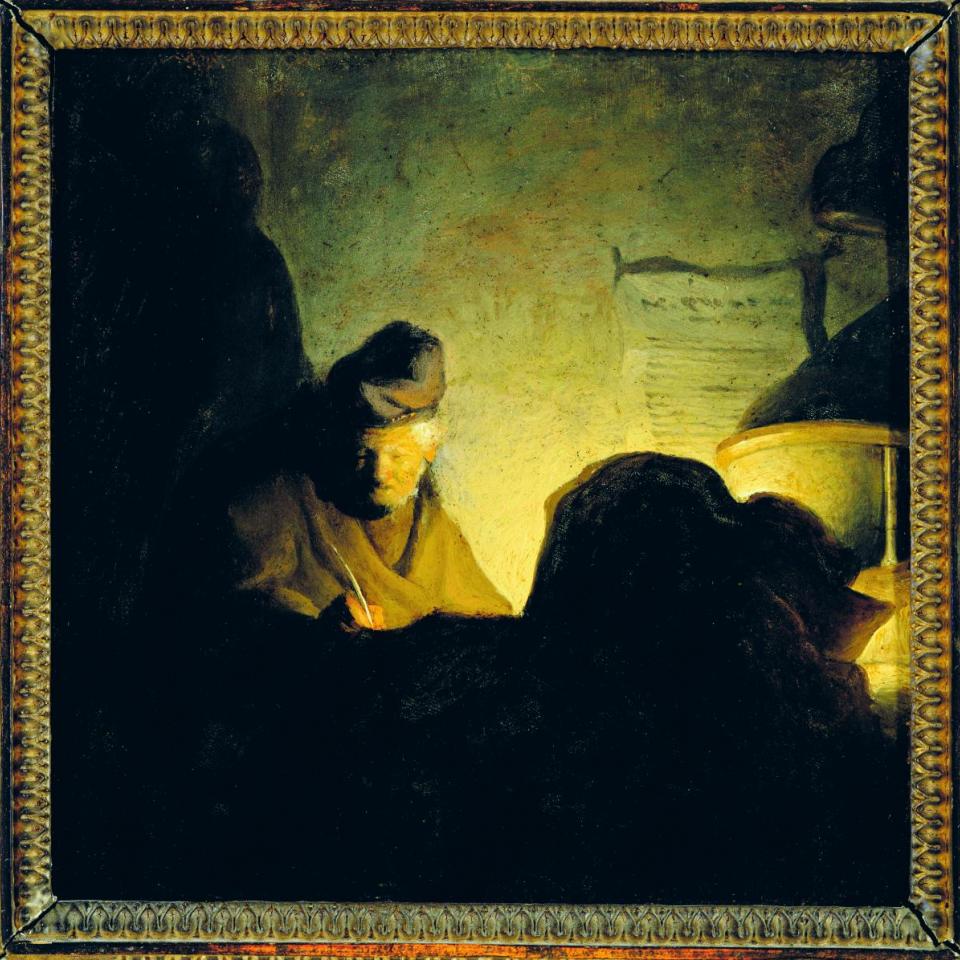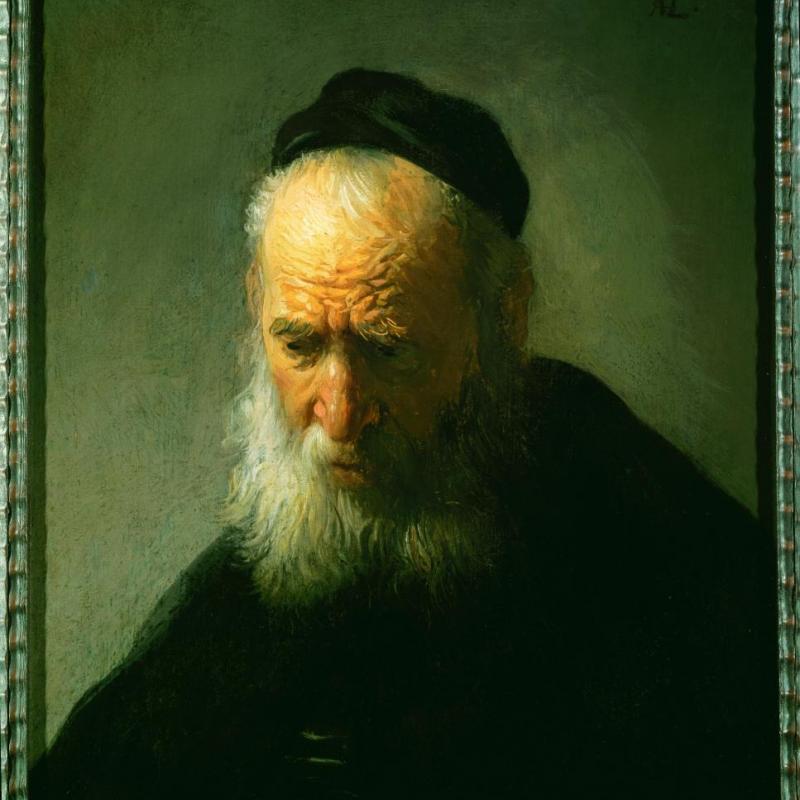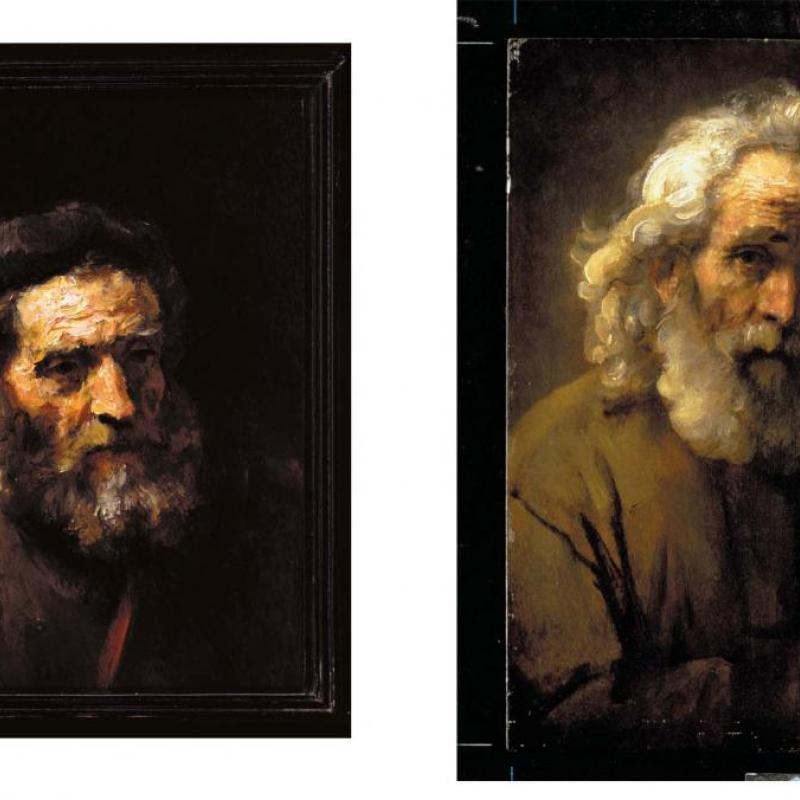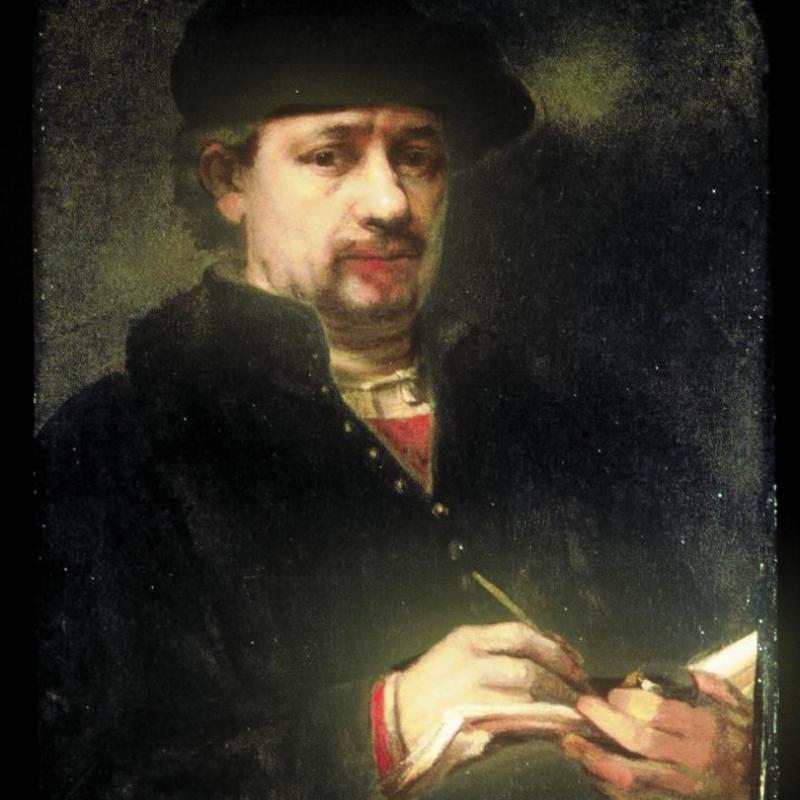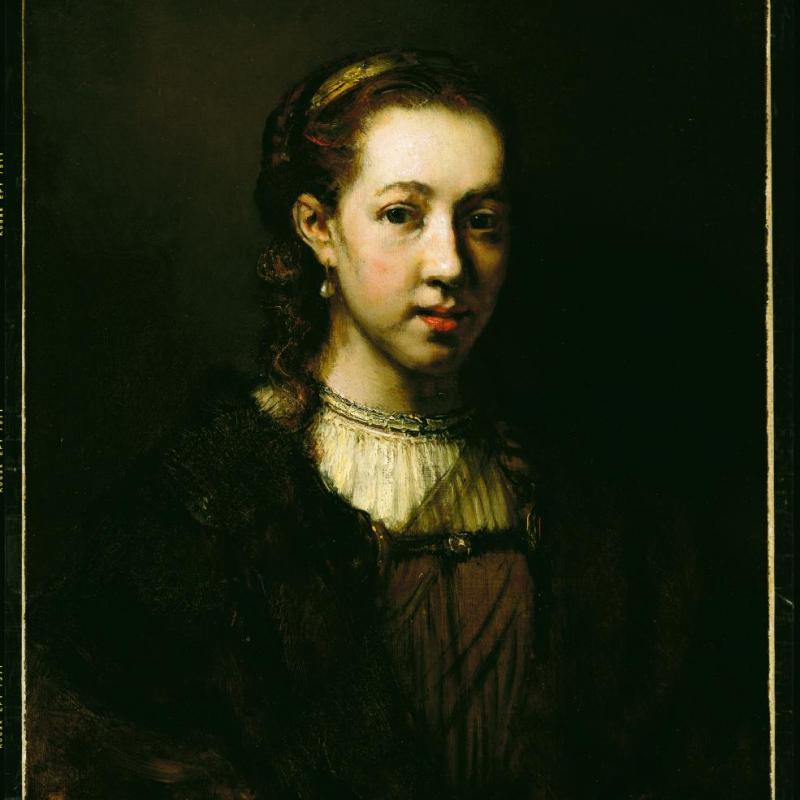Ever since listening to the renowned art historian Jakob Rosenberg’s lecture on Rembrandt at Harvard in 1948, I hoped that some day I would be able to acquire one of Rembrandt’s paintings. The first opportunity arose in 1959 when I bought from its Viennese owner a small work on copper depicting A Scholar by Candlelight. I purchased it subject to Rosenberg’s accepting it as a Rembrandt, which he did after close inspection at Harvard during a week I left it with him.
Two members of the Amsterdam-based Rembrandt Research Project (RRP), S.H. Levie and Ernst van de Wetering, examined this painting in my house in September 1972 and told me during their visit that they believed it to be an early work by Rembrandt, in paint handling very similar to that of his Flight into Egypt in Tours, France. The RRP then asked me to bring it to Amsterdam in 1973 and, in Volume I of the Corpus that appeared in 1982, gave both my painting and that in Tours “C” numbers (indicating not by Rembrandt, but by his “circle”) – C18 and C5, probably by the same artists from Rembrandt’s immediate circle.
From November 2001 to May 2002 the museum in Kassel and the Museum het Rembrandthuis in Amsterdam held an exhibition, “The Mystery of the Young Rembrandt,” which included the Flight into Egypt as a Rembrandt and my painting hanging next to the Flight as a Rembrandt or Circle of Rembrandt.
The history of this painting and the question of attribution are clearly described in the 2007 Bader Collection Catalogue, which was prepared by David de Witt, the Bader Collection curator at the Agnes Etherington Art Centre. My next Rembrandt acquisition, again initially C22 in the Corpus, was the Head of an Old Man in a Cap,which I was able to purchase very inexpensively at Christie’s in London in March 1979. I was convinced of its authenticity, but as the Christie’s catalogue stated that the RRP did not accept it, there was little bidding competition. Volume I of the Corpus, published in 1982, gives a three-page discussion of this painting, beginning with the summarized opinion that C22 is “a well-preserved painting from Rembrandt’s immediate circle, reproduced in 1634 as his invention in an etching by J.G. van Vliet [1605-1668?].” However, following Section 4 Comments is this note: “December 1979 – One of the authors (van de Wetering) does not rule out the possibility of C22 being an autograph work by Rembrandt.”
As David de Witt has pointed out in his Bader catalogue, “The turning point came with the 1996 exhibition on Rembrandt and van Vliet in the Rembrandthuis in Amsterdam, where it was proven that van Vliet and Rembrandt collaborated on some prints, and that the watermarks appearing in the paper on some examples also appeared in impressions of van Vliet’s print after the present painting. Evidently, Rembrandt returned regularly to Leiden to direct the work of Van Vliet, and so there would not have been a mistake about the authorship of the present painting. Since the 1996 exhibition, scholars have generally voiced approval of the attribution to Rembrandt.”
My wife Isabel and I gave this painting to Queen’s in 2003, the first of several Rembrandts intended to go to the university.
In his two-volume work on Rembrandt published in 1949, Jakob Rosenberg illustrated two heads of old men side by side on one page. Both of these subsequently came up at auction. The one I liked particularly (figure 100 in Rosenberg’s book) was offered in the sale of the famous Alfred W. Erickson collection at Parke-Bernet in New York in November 1961. There it was one of three Rembrandts, the most famous of which – Aristotle Contemplating the Bust of Homer – was purchased by the Metropolitan Museum for $2.3 million. The other two Rembrandts were estimated very reasonably, and so I flew to New York to bid for the Head of an Old Man With Curly Hair, signed and dated Rembrandt f. 1659. I was not the only one to love this work, however, and Derek Cotton, a collector in Birmingham, England, bought it for $180,000. This was far more than I was able to pay at that time. My salary was very modest; my business the Aldrich Chemical Company, was still a small company and had not yet gone public.
In the 1970s, the RRP must have indicated they did not accept it as genuine, and when Derek Cotton’s son offered it at Christie’s London in April 1993 it was described as Circle of Rembrandt, estimated at £60,000-£80,000. I was at the sale, once again hoping to buy it, but when I noted that no one was bidding, I decided not to bid either. I made a much lower bid after the sale, and that was accepted.
Both of my sons, David and Daniel, are serious collectors of paintings, and each will have two of my best paintings. Daniel has really loved this Old Man, and so I gave it to him. The painting has again been carefully examined by Van de Wetering, and he has told us he is now certain of its authenticity. He borrowed it, with three other works, for a small exhibition in Amsterdam in 2005 entitled, “Rembrandt’s Studies: New Light on an Old Problem.” In 2006 it was included in the great Rembrandt exhibitions in the Rembrandthuis and in Berlin in celebration of 400 years since the artist’s birth.
Is it by Rembrandt? I am not totally certain, as I am not certain of some of Van de Wetering’s other new attributions, but I love it, as does Daniel. Again, this painting is carefully described in David de Witt’s Bader catalogue, which contains descriptions of two paintings that will not come to Queen’s because it is Daniel’s and a second, Joseph and the Baker by a Delft Rembrandt student, which will go to David.
The second of the two paintings illustrated by Jakob Rosenberg in his book is a Head of a Bearded Man: Study for St. Matthew. I bought it as Circle of Rembrandt at Christie’s in February 1995.
David de Witt has noted that Abraham Bredius, the Dutch art historian and museum director, identified the painting in his 1936 book The Paintings of Rembrandt “as autograph, but groups it with three other small panels showing the same model in slightly varying views. However, none of these other works approaches its decisive handling and structure….”
Isabel and I took this painting to the National Gallery in Washington where the curator, Arthur Wheelock, allowed us to compare it with their version. His comments were, “I cannot tell you whether your version is by Rembrandt, but I can tell you that yours is much better than ours.”
Rembrandt/Not Rembrandt: clearly the jury is still out, but whether by the master or one of his students, it has given us a great deal of pleasure.
Perhaps my happiest acquisition was that of a painting called Study of an Old Man in Profile on panel, offered from the John Hay Whitney collection at Sotheby’s in New York in May 2000. Described as Circle of Rembrandt, its value was estimated at only $40,000 to $60,000. Bidding by telephone, I was prepared to go very high, as I believed there was a good chance it was an original Rembrandt, and I was very happy when the auctioneer, George Gordon, knocked it down to me for $125,000. Our good friend George hand-delivered it when he came to Milwaukee on a visit to the Midwest after the sales.
Removing the dirty old varnish was easy; my colleague and friend Charles Munch told me that he had seldom worked on a 17th-century panel in such good condition. I was eager to show it to van de Wetering and offered to take it with us when we went to Amsterdam that November. Ernst spent a long time with the little panel when we showed it to him, and Peter Klein of Hamburg, who happened to be visiting him at the time, took a small sample of the wood and determined by dendrochronological study that a date around 1661 was likely. Ernst asked us to bring the panel to the Rijksmuseum the next day, so that he could compare it with Rembrandt’s Self-Portrait as the Apostle Paul, which is signed and dated 1661.
In the Rembrandthuis exhibition catalogue of 2006, “Rembrandt – Quest of a Genius,” Ernst wrote: “This small painting, evidently related to Rembrandt’s Circumcision of Christ in the Stable in 1661 in Washington, originated rather late in Rembrandt’s career. In the Circumcision, several old men – including the Mohel who carries out the circumcision and a man who writes in a book – are depicted in roughly the same way as the man in this study.
“Now that the thick layer of varnish has been removed from this painting, it can be seen as a small masterpiece, both as regards colour and peinture. It has been executed at a high tempo, wet in wet. With all its dynamism, it betrays such an astonishing control of the pictorial means available and, as a result, such a supreme sense of form on the part of its author, that one can scarcely imagine it could have been painted by a pupil. Nor could it be a copy, executed by a pupil, after one of the figures in the Washington Circumcision; the visual 'information' in the Circumcision is simply too scant for that.
“In its execution and colour scheme, the Study of an Old Man in Profile shows a striking resemblance to Rembrandt’s Self-Portrait as Paul from 1661 in the Amsterdam Rijksmuseum. Confrontation between these two paintings leaves no room for doubt as to the study’s authenticity. On this basis alone, it may be assumed that the study originated around 1661, the year in which the Washington Circumcision originated, according to the date applied to that painting. We can safely accept, therefore, that the small painting from the Bader collection was a preparatory study for the Circumcision.”
This painting was also in van de Wetering’s small 2005 exhibition and in the Rembrandt exhibition in Berlin in 2006.
One of the best dealers in Old Master paintings I have ever known was Neville Orgel in London. Despite his great knowledge, he was pessimistic and so self-effacing that he asked me not to mention his name in my first volume of autobiography. I bought many paintings from him before he moved from London to Israel, where he died in 2003. In 1977, on one of my rare visits to his home in Golder’s Green, I saw a fine Portrait of Rembrandt With a Sketchbook … In 1970, Neville had sent a photograph of his painting to Dr. Kurt Bauch, the great Rembrandt expert in Germany. He had replied that he preferred Neville’s portrait to those in Dresden and San Francisco, but did not believe that Neville’s was by Rembrandt. I loved the portrait. Neville was not keen to sell it (he had never taken it to his gallery), but he said he would sell if I paid him enough to buy an apartment he wanted in Israel – £40,000.
Since then, it has hung over my desk at home and given me a great deal of pleasure. It has graced the cover of an Aldrich catalogue and has been in two exhibitions at Purdue, two at Queen’s, and one entitled “The Detective’s Eye” at the Milwaukee Art Museum. There are six versions of this portrait, and at first I had hoped that mine might be an original Rembrandt. It is not. Volume IV of the Rembrandt Research Project deals only with his self-portraits. In this volume, van de Wetering has written about all six versions, including mine, which he has illustrated extensively…coming to the conclusion that it is a period portrait of the artist, but not even painted in Rembrandt’s workshop.
Over the years, I kept Neville informed about my findings, and shortly before he died he offered to repurchase my portrait for $100,000. I declined. I just like it too much, no matter who painted it.
The last Rembrandt/Not Rembrandt painting I acquired was the Portrait of a Woman, which perhaps is a likeness of Hendrickje Stoffels, the woman who became Rembrandt’s partner following the death of his wife.
Who painted this portrait? In 1979, when I purchased The Head of an Old Man … at an auction at Christie’s London, I was convinced that it was by Rembrandt, although the RRP was not. Now it is universally accepted. With the painting Bredius designated in his book as number 112, however, I am not convinced, but love it and, like the four dealers who owned it until February 2003, I have been searching for a name. It is certainly period. Drost has been suggested, but it is not like any of the 38 works accepted by Jonathan Bikker. David deWitt … thought briefly of Abraham van Dyck (1633-59), and that is close, but I have two of van Dyck’s signed works at home, and the paint handling is not quite the same. Now de Witt has considered the possibility that Bredius 112 might be by Jacobus Leveck (1634-75), working in Rembrandt’s studio in the 1650s. Again, a detailed history and description of this painting are given in the Bader Collection Catalogue of 2007.
Ernst van de Wetering of the RRP, has told me that he hates the painting. What a strange reaction to a painting that Jakob Rosenberg had loved and considered a great Rembrandt and which was the frontispiece in colour of the catalogue of the Rembrandt exhibition in Chicago in 1969. Paintings do cause strong emotions, and I buy for my own collection only paintings I really love. This is one of them.
This article originally ran in issue 4, 2007 of the Queen's Alumni Review. In 2019, Daniel Bader and his wife, Linda, donated Head of an Old Man with Curly Hair, now authenticated as being by Rembrandt, to the Agnes Etherington Art Centre, in memory of Alfred Bader, who died Dec. 23, 2018. The painting is now the fourth Rembrandt held by the Agnes. It is on display in The Bader Gallery at the art centre.
